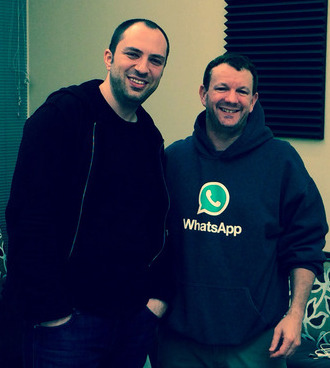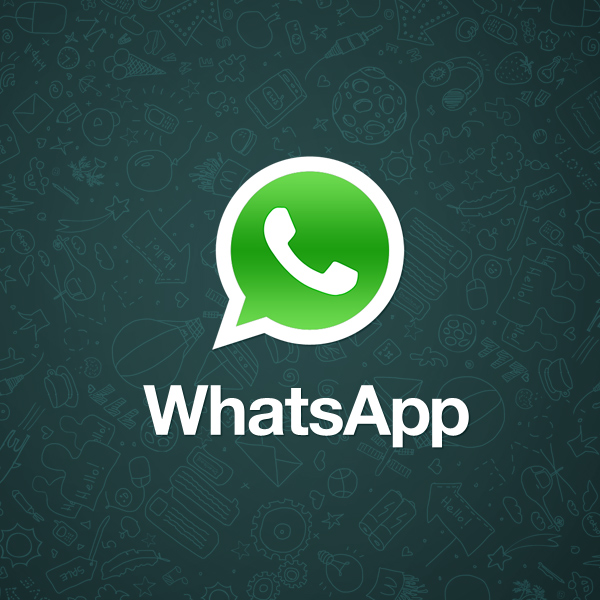How WhatsApp Was Started? The Start-Up Story Of Kan Koum & Brian Acton
This is one of those stories that are a little hard to believe, but it is completely real. A story about a young guy, who came up with a bright idea and cashed it out for $16 billion of dollars. Jan Koum, one of the founders of WhatsApp is now one of the richest people in the world, and he made all this in just a few years. Here is how it all happened…
WhatsApp History
Jan Koum was born on Feb 24, 1974, in Kyiv, Ukraine, to a family of Jewish origin. Back in 1992, he and his mom moved to California, US, where they lived in a small apartment that they got with the help of social support program there. Jan was 16 years old back then and he and his mother hardly made the ends meet. The young boy worked as a cleaner at a shop for some time to help the family financially.
When the young Koum was 18, he got interested in coding. He got accepted into the San Jose State University where he studied computer science and managed to find a job as a tester at Ernst & Young. This was actually where Jan met his future partner – Brian Acton.
In 1997, when Koum was 21, he got hired by Yahoo! and started work there as an IT-infra engineer (he dropped out of college shortly after that). Then Brian also joined the company and they worked together for the Internet giant for many years. An interesting fact is that Brian invested and lost millions of dollars in the .com burst that happened in the year 2000. Probably this was why he stayed for so long on his job. After almost a decade, in Sep 2007, both Jan and Brian decided to leave Yahoo! and chase other opportunities. They actually, took a whole year off and spent the time traveling across South America and relaxing. The two friends tried to get a job on Facebook but eventually, none of them got hired. That was actually a very expensive mistake for Mark Zuckerberg :), as he would later pay billions of dollars for acquiring the chat app… Also, this is a very bright example of how one closed door opens another. If Brian and Jan were not rejected, they would probably never found WhatsApp and would be still working as engineers…
In Jan 2009, caught by the “i” mania, Koum purchased an iPhone. He immediately realized the huge potential in front of the mobile apps industry. He shared his enthusiasm with his friend – Alex Fishman, and they both, along with Brian discussed for hours Koum’s idea about a chat app. This was when the name WhatsApp was born actually, it sounded like “what’s up”. They needed an experienced developer as non of the three had sufficient coding knowledge. Fishman managed to find one on the Russian freelance site – RentACoder.com. This guy was Igor Solomennikov, who was introduced to Koum and became the first software engineer in the company (he worked there up to 2018). Jan wasted no more time, on his birthday, Feb 24, 2009, he officially founded the company “WhatsApp Inc.”.
The Launch
Initially, the new WhatsApp 1.0 was not a great success. Its early versions had so many bugs, crashed too often, and was missing so many features that Koum was seriously thinking of giving up a couple of times. He even started looking for a new job but Acton managed to convince him to wait for another couple of months and give their new venture a chance.
Everything started getting a little bit better after, in June 2009, Apple released the functionality called push notifications, with the help of which WhatsApp v 2.0 had some additional functionalities and could notify everyone in the user’s group of his/her status change. After that release, the number of active users of the app suddenly went up to nearly 250 000.
At that time Acton was still unemployed, he was running another start-up himself… However, realizing the potential of WhatsApp he decided to give up his other activities and joined the company. In October, he managed to persuade 5 former Yahoo! colleagues to invest $250k in the WhatsApp start-up. This was how he himself also got a stake in the company and became one of the co-founders (He officially joined on Nov 1, 2009).
After more than half a year in development, the first stable version of WhatsApp was ready and it was officially released on the App Store in Nov 2009. Chris Peiffer was also hired to develop the version for BlackBery that was released a couple of months later.
Now everything was in its place and WhatsApp just took off. The number of users started growing, it was growing so fast that the app turned to paid form free in a trial by the founders to limit the uncontrollable growth. In December 2009, some new features were released, one of which enabled users to send pictures over the app…
By the beginning of 2011, WhatsApp made it to the top 20 list of apps on the App Store.
In April 2011, after a long period of negotiations, the famous venture capital company – Sequoia Capital invested about $8 million in the start-up, buying just 15% of it. This valued the whole company at over $50 million. In 2013, Sequoia invested another $50 million valuing this time WhatsApp at 1,5 billion.
Facebook Buys WhatsApp For 19 Billion
On February 9, 2014, Koum was invited to a private dinner. The invitation came from not anyone else, but Mark Zuckerberg himself. At the dinner in Marks’s home, Koum was officially offered to join the Facebook board of directors. 10 days after that an announcement was released that Facebook was buying WhatsApp for the mind-blowing $19 billion. The biggest social network would pay $4 billion in cash and the rest $12 billion would be paid with Facebook shares. According to the agreement, an additional $3 billion in restricted stock units would be granted to WhatsApp’s founders and employees that would vest over four years subsequent to finishing the deal. This made Jan Koum and Brian Acton billionaires overnight.
Over the next years, WhatsApp has been growing, Koum and Acton have always followed a simple rule – no ads, no marketing. They wanted WhatsApp to be just a simple and powerful instant messaging mobile application. This was probably one of the main reasons for the success of the app. Almost every user hates ads popping here and there and this was one of the reasons people chose this one. They didn’t sell advertising and they didn’t buy it. Probably there is no such company in the USA, not spending even a dime on marketing. And this turned out to be a strategy for billions.
Over the years, people liked WhatsApp more and more. The number of registered users has been increasing really rapidly. Today, the number of daily active users has reached 500 million, and it’s currently growing with around 25 million per month. The instant messages sent via the platform are around 20 billion daily.
Facebook recently announced that they are planning to create their own cryptocurrency that will allow WhatsApp users to make micropayments between each other, independently, on the blockchain. These plans are yet to be delivered.
Interesting Facts About WhatsApp
1. Did you know that the idea of WhatsApp was conceived in a bar in Barcelona? In December 2007, Ukrainian immigrants Jan Koum and Brian Acton had just been turned down for jobs at Facebook and were drowning their sorrows in some beer. It was then that they came up with the idea of building a messaging platform that could link users regardless of their network or phone subscriptions. After only a few days of planning, they already had an idea of what the service would be like.
2. WhatsApp was launched on January 2009 and within only five years, it had achieved one billion users. As of April 2020, it is the most widely used messaging app in the world with more than two billion active monthly users! This success can be attributed to its user-friendly features such as end-to-end encryption for secure communications and cross-platform compatibility for platform agnosticism.
3. WhatsApp was initially free for their first year of usage and then later started charging an annual $0.99 fee for all users after their first year — those who signed up after a year had to pay a set $1 fee. However, this subscription fee has since been removed in January 2016, allowing users to enjoy using the messaging service without cost throughout its usage period.
4. WhatsApp provides one of the highest levels of security when it comes to communicating with your friends and colleagues online; all messages sent over the platform are encrypted end-to-end – so you can be sure that your private conversations remain exactly that – private! As WhatsApp continuously updates its security protocol, the level of protection offered on our end continues to increase — so you can feel secure when you’re chatting away on WhatsApp.
5. You Can Use It on Multiple Devices at Once. Apart from being able to access your conversations on both your desktop computer or laptop as well as your mobile phone or tablet device at once — sending texts or making voice calls is as easy as ever with this messaging app. There’s no need to switch between devices or manage multiple apps— if you have a working internet connection then you can use WhatsApp irrespective of what device you’re accessing it from.
6. The chat application currently introduces a feature allowing users to make payments to each other. This was initially rolled out only in India but very soon it’s going to spread to more countries. Payments open a whole new universe of ways for using the application – from making payments to family and friends, to online shopping, crowdfunding, and a lot more… The digital payments industry is a huge and lucrative business. Offering such a feature to the 1 billion+ user base of the chat totally makes sense.
WhatsApp Today
In today’s digital world, WhatsApp is one of the most popular messaging applications used by millions of people around the world. Developed by Facebook, the application is used by people of all ages, from teenagers to seniors. It is available for almost any device: Android, iPhone, Nokia, Windows Phone, etc. You can even use a web version of it (see how at the end of the post). Everyone can download it and still use it for free.
WhatsApp is used by many millions of people around the world and continues to grow in popularity. It is now available in more than 180 countries, and more than 1.5 billion people use it every day. The app is a great way to stay connected with friends, family, and colleagues. It allows users to easily send messages, photos, videos, and audio recordings. It also offers end-to-end encryption, meaning only the sender and recipient can see the messages. This makes it a secure way to communicate.
Many businesses have started using WhatsApp as a way to reach out to their customers. Companies can create customer service chatbots that interact with customers through WhatsApp messages which enhances the customer support experience as customers no longer have to wait on hold or make an appointment for any sort of inquiries right away. This technology has significantly improved customer experience as issues can be addressed faster via chats with automated responses without human intervention when needed leading to improved customer satisfaction metrics for the businesses.
In addition to its widespread use for regular day-to-day communication purposes amongst family & friends or businesses communicating with customers or colleagues, WhatsApp is being used for other use cases such as community meetups organizing events & activities, healthcare specifically remote consultation amongst doctors & patients using video calls & sharing medical reports securely, creating ‘digital neighborhoods’ where citizens can communicate concerning local news & city programs among many more use cases as more entrepreneurs & developers leverage the features of this powerful platform in creative ways for solving real-world problems.
Interesting Resources – Where to Download WhatsApp
The official site of the chat application where you can find where to download it from for the device and OS that you use: https://www.whatsapp.com/
WhatsApp Web – https://web.whatsapp.com/ – The service allows users to access their chats from a computer or laptop through a web browser. This can be especially convenient in a work environment; instead of constantly having to pull out your phone from your pocket, you can open a tab on your browser while at your desk and quickly check in on conversations without disrupting connected tasks.
WABetaInfo: This site provides detailed information on upcoming features of WhatsApp, including scrubbed updates and features that have not been officially released yet. New evidence exists on the site’s home page that shows a variety of hardware ranging from PC to mobile devices that use WhatsApp’s messaging services today
WhatsAppDB: Here, users can find some amazing stories, statistics, and data regarding how people use WhatsApp around the entire world. With its global coverage, users also stay up-to-date on the latest trends related to WhatsApp usage in every continent.








